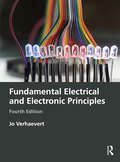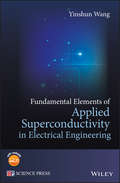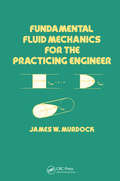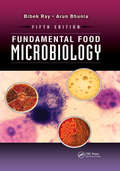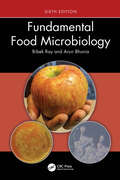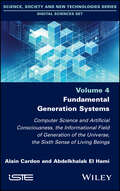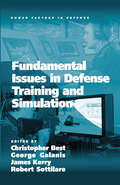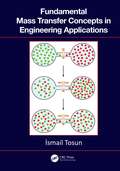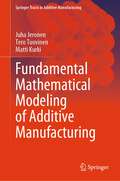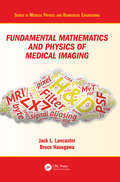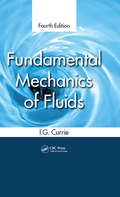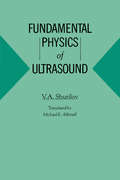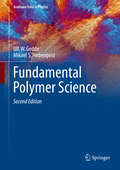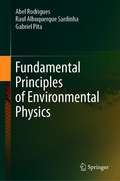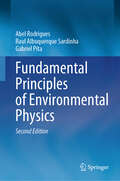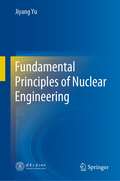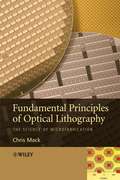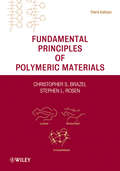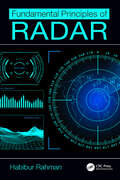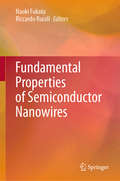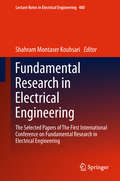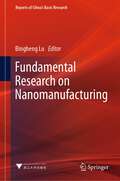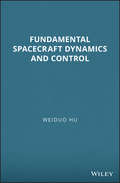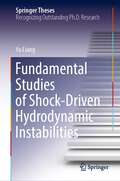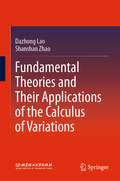- Table View
- List View
Fundamental Electrical and Electronic Principles
by Jo VerhaevertFundamental Electrical and Electronic Principles covers the essential principles that form the foundations for electrical and electronic engineering courses. This new edition is extensively updated with a greater focus on electronic principles, evenly balanced with electrical principles. Fuller coverage is given to active electronics, with the additional topics of diodes and transistors, and core topics such as oscilloscopes now reflect state-of-the-art technology.Each main chapter starts with learning outcomes tied to the syllabus. All theory is explained in detail and backed up with numerous worked examples and handy summaries of equations. Students can test their understanding with end-of-chapter assignment questions for which answers are provided. The book also provides detailed suggested practical assignments outlining apparatus and methods.The book forms an excellent core work for beginning further education students with some mathematics background preparing for careers as technicians, and an introductory text for first-year undergraduate students in all engineering disciplines.
Fundamental Elements of Applied Superconductivity in Electrical Engineering, 1st Edition
by Yinshun WangSuperconducting technology is potentially important as one of the future smart grid technologies. It is a combination of superconductor materials, electrical engineering, cryogenic insulation, cryogenics and cryostats. There has been no specific book fully describing this branch of science and technology in electrical engineering. However, this book includes these areas, and is essential for those majoring in applied superconductivity in electrical engineering. Recently, superconducting technology has made great progress. Many universities and companies are involved in applied superconductivity with the support of government. Over the next five years, departments of electrical engineering in universities and companies will become more involved in this area. This book: * will enable people to directly carry out research on applied superconductivity in electrical engineering * is more comprehensive and practical when compared to other advances * presents a clear introduction to the application of superconductor in electrical engineering and related fundamental technologies * arms readers with the technological aspects of superconductivity required to produce a machine * covers power supplying technologies in superconducting electric apparatus * is well organized and adaptable for students, lecturers, researchers and engineers * lecture slides suitable for lecturers available on the Wiley Companion Website Fundamental Elements of Applied Superconductivity in Electrical Engineering is ideal for academic researchers, graduates and undergraduate students in electrical engineering. It is also an excellent reference work for superconducting device researchers and engineers.
Fundamental Fluid Mechanics for the Practicing Engineer (Mechanical Engineering)
by James W. MurdockA step-by-step guide, containing tutorial examples that serve as models for all concepts presented. This text contains properties of nearly 50 fluids, including density and viscosity data for compressed water and superheated steam, and characteristics of areas, pipes and tubing.
Fundamental Food Microbiology
by Bibek Ray Arun BhuniaThe golden era of food microbiology has begun. All three areas of food microbiology-beneficial, spoilage, and pathogenic microbiology-are expanding and progressing at an incredible pace. What was once a simple process of counting colonies has become a sophisticated process of sequencing complete genomes of starter cultures and use of biosensors to
Fundamental Food Microbiology
by Bibek Ray Arun BhuniaFood microbiology has seen enormous growth in the last decade, fueled by the global pandemic of COVID-19 and continual routine outbreaks with traditional foodborne pathogens. In addition, climate change and global warming also affect agriculture and food production, in turn shifting microbial ecology. Such changes will affect pathogen behavior, spoilage, and microbial growth, impacting food safety and quality. Health-conscious consumers are also looking for foods with alternative protein sources from plants and insects, such as fermented, antioxidant, and micronutrient-rich superfoods. All three areas of food microbiology—beneficial, spoilage, and pathogenic microbiology—are expanding and progressing incredibly. What was once a simple process of counting colonies has become a sophisticated process of sequencing complete genomes, gene editing, and biotechnology for starter cultures and probiotics improvement and application of sophisticated analytical tools for microbial analysis.Fundamental Food Microbiology, Sixth Edition captures these developments and broadens coverage of foodborne disease mechanisms, spoilage microbes, and microbial inactivation strategies. Written by experts with approximately sixty years of combined experience, the book provides an in-depth understanding of how to reduce microbial food spoilage, improve intervention technologies, and develop effective control methods for different types of foods.See What’s New in the Sixth Edition Condensed chapter descriptions with illustrations CRISPR/Cas system for gene editing Novel food processing technologies, including plasma and micro/nanobubble technologies Food radiation and hurdle concept chapters are merged and overhauled Comprehensive list of mycotoxins and seafood-related toxins Updates on several new antimicrobial compounds from animal and plant sources Maintaining the high standard set by the previous bestselling editions, and based on feedback from students and professors, this new edition includes even more easy-to-follow figures and illustrations. The chapters are presented logically, connecting the information and allowing students to understand and retain the concepts presented easily. These features make this a comprehensive introductory text for undergraduates and a valuable reference for graduate-level and working professionals in food microbiology, food safety, or food technology.
Fundamental Generation Systems: Computer Science and Artificial Consciousness, the Informational Field of Generation of the Universe, the Sixth Sense of Living Beings
by Alain Cardon Abdelkhalak El HamiThere are many different ways of generating representations. This includes representations generated by living beings while comprehending reality in order to act; representations generated by the Universe during its extensive unfolding, creating physical elements and living beings; and the direct representation of elements through an animal’s sixth sense. To this list we must now add the creation of artificial consciousness, which generates representations that resemble the mental representations of humans. These representations allow robotic systems to communicate directly with each other.Fundamental Generation Systems develops a theory which presents, from the beginning, the function of this sixth sense called the “sense of informational comprehension”. This sense is understood as an ability to use the informational foundations of the Universe via a dedicated cerebral domain found in every animal.
Fundamental Issues in Defense Training and Simulation (Human Factors in Defence)
by George Galanis Robert SottilareDefense forces have always invested a great deal of their resources in training. In recent times, changes in the complexity and intensity of operations have reaffirmed the importance of ensuring that warfighters are adequately prepared for the environments in which they are required to work. The emergence of new operational drivers such as asymmetric threats, urban operations, joint and coalition operations and the widespread use of military communications and information technology networks has highlighted the importance of providing warfighters with the competencies required to act in a coordinated, adaptable fashion, and to make effective decisions in environments characterized by large amounts of sometimes ambiguous information. While investment in new technologies can make available new opportunities for action, it is only through effective training that personnel can be made ready to apply their tools in the most decisive and discriminating fashion. There are many factors which can have an impact on the efficacy of training and many issues to consider when designing and implementing training strategies. These issues are often complex and nuanced, and in order to grasp them fully a significant investment of time and energy is required. However, the requirement to respond quickly to ever-changing technology, a high operational tempo and minimal staffing may preclude many in today's defense forces from seeking out all such resources on their own. This edited collection provides brief, easy-to-understand summaries of the key issues in defense training and simulation, as well as guidance for further reading. It consists of a collection of short essays, each of which addresses a fundamental issue in defense training and simulation, and features an up-to-date reference list to enable the reader to undertake further investigation of the issues addressed. In essence, this book provides the optimum starting point, or first resource, for readers to come to terms with the important issues associated with defense training and simulation. The contributions are written by leading scholars from military research institutions in the US, UK, Canada, Australia and New Zealand, as well as selected researchers from academic and private sector research institutions.
Fundamental Mass Transfer Concepts in Engineering Applications
by Ismail TosunFundamental Mass Transfer Concepts in Engineering Applications provides the basic principles of mass transfer to upper undergraduate and graduate students from different disciplines. This book outlines foundational material and equips students with sufficient mathematical skills to tackle various engineering problems with confidence. It covers mass transfer in both binary and multicomponent systems and integrates the use of Mathcad® for solving problems. This textbook is an ideal resource for a one-semester course. Key Features The concepts are explained with the utmost clarity in simple and elegant language Presents theory followed by a variety of practical, fully-worked example problems Includes a summary of the mathematics necessary for mass transfer calculations in an appendix Provides ancillary Mathcad® subroutines Includes end-of-chapter problems and a solutions manual for adopting instructors
Fundamental Mathematical Modeling of Additive Manufacturing (Springer Tracts in Additive Manufacturing)
by Juha Jeronen Tero Tuovinen Matti KurkiThis book elucidates the fundamental thermomechanical behaviour inherent in the 3D printing process within a laser-based powder bed fusion (L-PBF) system. It presents foundational concepts and provides in-depth derivations of the governing equations. The analysis encompasses arbitrary anisotropic linear viscoelastic materials, accounting for thermal effects. The authors leverage the theory of axially moving materials, a framework previously employed in the analysis of production processes within the process industry. They introduce a coordinate frame that moves in tandem with the printing laser, adopting an Eulerian perspective towards the in-motion solid. Designed for graduate students and researchers, this book is poised to foster a profound comprehension and spur innovative technological advancements in the realm of additive manufacturing.
Fundamental Mathematics and Physics of Medical Imaging (Series in Medical Physics and Biomedical Engineering)
by Jack Lancaster Bruce HasegawaAuthored by a leading educator, this book teaches the fundamental mathematics and physics concepts associated with medical imaging systems. Going beyond mere description of imaging modalities, this book delves into the mechanisms of image formation and image quality common to all imaging systems: contrast mechanisms, noise, and spatial and temporal resolution, making it an important reference for medical physicists and biomedical engineering students. This is an extensively revised new edition of The Physics of Medical X-Ray Imaging by Bruce Hasegawa (Medical Physics Publishing, 1991), and includes a wide range of modalities such as X-ray CT, MRI and SPECT.
Fundamental Mechanics of Fluids
by I. G. CurrieFundamental Mechanics of Fluids, Fourth Edition addresses the need for an introductory text that focuses on the basics of fluid mechanics-before concentrating on specialized areas such as ideal-fluid flow and boundary-layer theory. Filling that void for both students and professionals working in different branches of engineering, this versatile ins
Fundamental Physics of Ultrasound
by ShutilovBased on lectures by the author, this volume is designed as a textbook on general ultrasonics. The text provides coverage of the propagation of ultrasonic waves in media with different elastic properties and under conditions close to those encountered in scientific and practical applications of ultrasound.
Fundamental Polymer Science (Graduate Texts in Physics)
by Ulf W. Gedde Mikael S. HedenqvistThis successor to the popular textbook, “Polymer Physics” (Springer, 1999), is the result of a quarter-century of teaching experience as well as critical comments from specialists in the various sub-fields, resulting in better explanations and more complete coverage of key topics. With a new chapter on polymer synthesis, the perspective has been broadened significantly to encompass polymer science rather than “just” polymer physics. Polysaccharides and proteins are included in essentially all chapters, while polyelectrolytes are new to the second edition. Cheap computing power has greatly expanded the role of simulation and modeling in the past two decades, which is reflected in many of the chapters. Additional problems and carefully prepared graphics aid in understanding. Two principles are key to the textbook’s appeal: 1) Students learn that, independent of the origin of the polymer, synthetic or native, the same general laws apply, and 2) students should benefit from the book without an extensive knowledge of mathematics. Taking the reader from the basics to an advanced level of understanding, the text meets the needs of a wide range of students in chemistry, physics, materials science, biotechnology, and civil engineering, and is suitable for both masters- and doctoral-level students. Praise for the previous edition: ...an excellent book, well written, authoritative, clear and concise, and copiously illustrated with appropriate line drawings, graphs and tables. - Polymer International ...an extremely useful book. It is a pleasure to recommend it to physical chemists and materials scientists, as well as physicists interested in the properties of polymeric materials. - Polymer News This valuable book is ideal for those who wish to get a brief background in polymer science as well as for those who seek a further grounding in the subject. - Colloid Polymer Science The solutions to the exercises are given in the final chapter, making it a well thought-out teaching text. - Polymer Science
Fundamental Principles of Environmental Physics
by Abel Rodrigues Raul Albuquerque Sardinha Gabriel PitaThis book is an interdisciplinary and accessible guide to environmental physics. It allows readers to gain a more complete understanding of physical process and their interaction with ecological ones underpin important environmental issues.The book covers a wide range of topics within environmental physics, including:• natural and anthropogenic canopies, including forests, urban or wavy terrains;• the fundamentals of heat transfer;• atmospheric flow dynamics;• global carbon budget;• climate change; and• the relevance of biochar as a global carbon sink.Including solved exercises, numerous illustrations and tables, as well as an entire chapter focused on applications, book is of interest to researchers, students and industrial engineers alike.
Fundamental Principles of Environmental Physics
by Abel Rodrigues Gabriel Pita Raul Albuquerque SardinhaThis book is an interdisciplinary guide to environmental physics grounded in sound mathematical formulation. Its holistic approach allows readers to gain a more complete understanding of physical processes and their interactions with ecological ones, which underpin important environmental issues. The primary focus is on the atmospheric surface layer and topsoil layers. This book interests researchers, students, agronomists, foresters, and urbanist engineers alike. The book covers a wide range of topics within environmental physics, including: • natural and anthropogenic canopies, including forests, urban or wavy terrains; • fundamentals of heat and mass transfer; • atmospheric flow dynamics; • eddy covariance and aerodynamic approaches for quantification of atmospheric fluxes; • global carbon budget; • soil-water relationships; • climate change; and • the relevance of biochar as a global carbon sink. Each chapter includes solved exercises, numerous illustrations, and tables. This refreshed and updated edition also contains a new chapter on soil-water relationships.
Fundamental Principles of Nuclear Engineering
by Jiyang YuThis book highlights a comprehensive and detailed introduction to the fundamental principles related to nuclear engineering. As one of the most popular choices of future energy, nuclear energy is of increasing demand globally. Due to the complexity of nuclear engineering, its research and development as well as safe operation of its facility requires a wide scope of knowledge, ranging from basic disciplines such as mathematics, physics, chemistry, and thermodynamics to applied subjects such as reactor theory and radiation protection. The book covers all necessary knowledge in an illustrative and readable style, with a sufficient amount of examples and exercises. It is an easy-to-read textbook for graduate students in nuclear engineering and a valuable handbook for nuclear facility operators, maintenance personnel and technical staff.
Fundamental Principles of Optical Lithography
by Chris MackThe fabrication of an integrated circuit requires a variety of physical and chemical processes to be performed on a semiconductor substrate. In general, these processes fall into three categories: film deposition, patterning, and semiconductor doping. Films of both conductors and insulators are used to connect and isolate transistors and their components.By creating structures of these various components millions of transistors can be built and wired together to form the complex circuitry of modern microelectronic devices. Fundamental to all of these processes is lithography, ie, the formation of three-dimensional relief images on the substrate for subsequent transfer of the pattern to the substrate.This book presents a complete theoretical and practical treatment of the topic of lithography for both students and researchers. It comprises ten detailed chapters plus three appendices with problems provided at the end of each chapter.Additional Information:Visiting http://www.lithoguru.com/textbook/index.html enhances the reader's understanding as the website supplies information on how you can download a free laboratory manual, Optical Lithography Modelling with MATLAB®, to accompany the textbook. You can also contact the author and find help for instructors.
Fundamental Principles of Polymeric Materials
by Christopher S. Brazel Stephen L. RosenNew edition brings classic text up to date with the latest science, techniques, and applicationsWith its balanced presentation of polymer chemistry, physics, and engineering applications, the Third Edition of this classic text continues to instill readers with a solid understanding of the core concepts underlying polymeric materials. Both students and instructors have praised the text for its clear explanations and logical organization. It begins with molecular-level considerations and then progressively builds the reader's knowledge with discussions of bulk properties, mechanical behavior, and processing methods.Following a brief introduction, Fundamental Principles of Polymeric Materials is divided into four parts:Part 1: Polymer FundamentalsPart 2: Polymer SynthesisPart 3: Polymer PropertiesPart 4: Polymer Processing and PerformanceThoroughly Updated and RevisedReaders familiar with the previous edition of this text will find that the organization and style have been updated with new material to help them grasp key concepts and discover the latest science, techniques, and applications. For example, there are new introductory sections on organic functional groups focusing on the structures found in condensation polymerizations. The text also features new techniques for polymer analysis, processing, and microencapsulation as well as emerging techniques such as atom transfer radical polymerization.At the end of each chapter are problems--including many that are new to this edition--to test the reader's grasp of core concepts as they advance through the text. There are also references leading to the primary literature for further investigation of individual topics.A classic in its field, this text enables students in chemistry, chemical engineering, materials science, and mechanical engineering to fully grasp and apply the fundamentals of polymeric materials, preparing them for more advanced coursework.
Fundamental Principles of Radar
by Habibur RahmanThe important and fascinating topics of radar enjoy an extensive audience in industry and government but deserve more attention in undergraduate education to better prepare graduating engineers to meet the demands of modern mankind. Radar is not only one of the major applications of electronics and electromagnetic communications, but it is also a mature scientific discipline with significant theoretical and mathematical foundations that warrant an intellectual and educational challenge. Fundamental Principles of Radar is a textbook providing a first exposure to radar principles. It provides a broad concept underlying the basic principle of operations of most existing radar systems and maintains a good balance of mathematical rigor to convince readers without losing interest. The book provides an extensive exposition of the techniques currently being used for radar system design, analysis, and evaluation. It presents a comprehensive set of radar principles, including all features of modern radar applications, with their underlying derivations using simple mathematics. Coverage is limited to the main concepts of radar in order to present them in a systematic and organized fashion. Topics are treated not as abstruse and esoteric to the point of incomprehensibility, but the very complex and rich technology of radar is distilled into its fundamentals. The author’s emphasis is on clarity without sacrificing rigor and completeness, thus making the book broad enough to satisfy a variety of backgrounds and interests. Thorough documentation provides an unusual degree of completeness for a textbook at this level, with interesting and sometimes thought-provoking content to make the subject even more appealing. Key Features: Covers a wide range of topics in radar systems Includes examples and exercises to reinforce the concepts presented and explain their applications Provides self-contained chapters useful for readers seeking selective topics Provides broad concepts underlying the basic principles of operations of most types of radars in use today Includes documentation to lead to further reading of interesting concepts and applications
Fundamental Properties of Semiconductor Nanowires
by Naoki Fukata Riccardo RuraliThis book covers virtually all aspects of semiconductor nanowires, from growth to related applications, in detail. First, it addresses nanowires’ growth mechanism, one of the most important topics at the forefront of nanowire research. The focus then shifts to surface functionalization: nanowires have a high surface-to-volume ratio and thus are well-suited to surface modification, which effectively functionalizes them. The book also discusses the latest advances in the study of impurity doping, a crucial process in nanowires. In addition, considerable attention is paid to characterization techniques such as nanoscale and in situ methods, which are indispensable for understanding the novel properties of nanowires. Theoretical calculations are also essential to understanding nanowires’ characteristics, particularly those that derive directly from their special nature as one-dimensional nanoscale structures. In closing, the book considers future applications of nanowire structures in devices such as FETs and lasers.
Fundamental Research in Electrical Engineering: The Selected Papers of The First International Conference on Fundamental Research in Electrical Engineering (Lecture Notes in Electrical Engineering #480)
by Shahram Montaser KouhsariThis volume presents the selected papers of the First International Conference on Fundamental Research in Electrical Engineering, held at Khwarazmi University, Tehran, Iran in July, 2017. The selected papers cover the whole spectrum of the main four fields of Electrical Engineering (Electronic, Telecommunications, Control, and Power Engineering).
Fundamental Research on Nanomanufacturing (Reports of China’s Basic Research)
by Bingheng LuThis book explores new principles and methods of nanomanufacturing based on physical/chemical effects through interdisciplinary research and reveals surface/interface effects and scale effects in processing, forming, modification, and cross-scale manufacturing at nanoscale and nanoscale precision. It is a summary of a major research project in the field of engineering and materials science of China, the “Fundamental Research of Nanomanufacturing”. It clarifies the evolution mechanism of material structure, establishes the accurate characterization and measurement method of nanomanufacturing process, develops some original nanomanufacturing processes and equipment, and provides theoretical basis for realizing the consistent batch process of nanomanufacturing. It reports a series of research breakthroughs in principles and methods of nano-precision manufacturing, nanoscale structure fabrication as well as efficient and multiscale fabrication of large area nanostructures.
Fundamental Spacecraft Dynamics and Control
by Weiduo HuAn extensive text reference includes around an asteroid – a new and important topic Covers the most updated contents in spacecraft dynamics and control, both in theory and application Introduces the application to motion around asteroids – a new and important topic Written by a very experienced researcher in this area
Fundamental Studies of Shock-Driven Hydrodynamic Instabilities (Springer Theses)
by Yu LiangThis book illustrates the latest progress on the hydrodynamic instabilities induced by a shock wave, particularly RM (Richtmyer–Meshkov) instability. The hydrodynamic instabilities play crucial roles in various industrial and scientific fields, such as inertial confinement fusion, supersonic combustion, supernova explosion, etc. This book experimentally and theoretically explores the shock-driven instabilities of complex gas-gas and gas-liquid interfaces. The main difficulty in performing an experimental study on RM instability, especially in a shock-tube circumstance, lies in creating an idealized initial interface because the RM instability is extremely sensitive to the initial condition. This book introduces new experimental methods to generate shape-controllable two-dimensional gaseous interfaces, thickness-controllable gas layers, and water droplets embedded with a vapour bubble in the shock-tube experiments. It covers the latest experiments and theories on the shock-driven hydrodynamic instabilities of multi-mode, multi-layer, and multi-phase interfaces. It explores the effects of the mode-competition, interface-coupling, and phase-transition on interface evolution, respectively. This book establishes a universal nonlinear theory to predict the RM instability of a shocked multi-mode interface based on spectrum analysis. This book quantifies the effects of interface-coupling and reverberating waves on the hydrodynamic instabilities of a shocked multi-layer interface. This book provides the experimental studies of the interaction of a shock wave and a multi-phase droplet and proposes a modified Rayleigh-Plesset equation to predict the vapour bubble collapse inside a droplet.
Fundamental Theories and Their Applications of the Calculus of Variations
by Shanshan Zhao Dazhong LaoThis book focuses on the calculus of variations, including fundamental theories and applications. This textbook is intended for graduate and higher-level college and university students, introducing them to the basic concepts and calculation methods used in the calculus of variations. It covers the preliminaries, variational problems with fixed boundaries, sufficient conditions of extrema of functionals, problems with undetermined boundaries, variational problems of conditional extrema, variational problems in parametric forms, variational principles, direct methods for variational problems, variational principles in mechanics and their applications, and variational problems of functionals with vector, tensor and Hamiltonian operators. Many of the contributions are based on the authors’ research, addressing topics such as the extension of the connotation of the Hilbert adjoint operator, definitions of the other three kinds of adjoint operators, the extremum function theorem of the complete functional, unified Euler equations in variational methods, variational theories of functionals with vectors, modulus of vectors, arbitrary order tensors, Hamiltonian operators and Hamiltonian operator strings, reconciling the Euler equations and the natural boundary conditions, and the application range of variational methods. The book is also a valuable reference resource for teachers as well as science and technology professionals.
